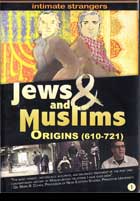
Jews & Muslims: Origins (610-721) 2013
Distributed by Film Ideas, 308 North Wolf Rd., Wheeling, IL 60090; 800-475-3456
Produced by PHares & Balises
Directed by Karim Miské
DVD, color, 52 min.
High School - General Adult
Islam, Middle East, History, Judaism
Date Entered: 06/03/2015
Reviewed by Sandra Collins, Byzantine Catholic Seminary Library, Pittsburgh, PAFrom the loosely affiliated polytheistic tribes of ancient Mecca came a mystic Bedouin named Mohammed, whose visions, drive and religious fervor led to the religion now recognized today as Islam. This film, the first in a 4-part series called Jews & Muslims: Intimate Strangers, deals with those beginnings up to the year 710, when Muslim rule expanded beyond North Africa across three continents and its effect on Judaism, especially in the Levant and Spain.
The film contextualizes the world out of which Mohammed comes: the tribal Bedouin communities of the 7th century Arabian Peninsula where religious identification was far less important than clan affiliations for both economic success and physical protection. Rather than employing reenactments, the film uses drawn images to express Mohammed’s new revelation that put him in earnest conversation with, but ultimately supersedes, the Abrahamic monotheistic religion of Judaism and, to a lesser extent, Christianity. Jewish influences can be seen in Islamic practices such as dietary regulations against eating pork, prayer towards Jerusalem (changed to Mecca after the Hijra, or exile) and seasons of fasting. Jewish as well as Arab/Islamic studies commentators all agree: Mohammed’s strict monotheism as well as the visions that come down to us today as the Koran (literally “the recitation”) were rejected not only by Jews and Christians but many of his Arab kinsmen. Because of this rejection, Mohammed strategically reorients some of these practices, including reading the Abraham-Isaac narrative of the Bible as the story of Abraham and his first son, Ishmael, as the promised heir. Subtly, then, we come to see that the Jewish-Islamic divide can on some level be characterized as a centuries-old conflict between two brothers, Ishmael, the father of the Arabs, and Isaac, a Jewish patriarch.
Eventually, Mohammed is thrown out of Mecca and reestablishes his family and followers in Medina. During this period of exile and return to Mecca, the film highlights the role of Jews in the communities in which Mohammed and his followers settled. Often at odds and feeling threatened, conflict inevitably led to imposed financial tribute, forced exile or death for the smaller, less organized Jewish enclaves. The film ends as a small force of Islamic fighters overtakes a hated Visigoth presence in Gibraltar where the Berbers are cheered by the Jews and Christians who live there under the oppression of the barbarian force.
This film does a satisfactory job of explaining the social and historical context of non-literate tribalism in nomadic Arab communities in the 7th century and how the changes that Islam brought about helped to break down those clan ties but also brought about conflicted religious ideologies where previously none (or, so it seemed) had existed. Its particular strength comes from highlighting Islamic contact with Judaism on the Arabian Peninsula and beyond. However, the tenets of Islam, beyond its monotheistic tilt, are never mentioned, including the content of the revelation of Gabriel/Ghibril in the Cave of Hira. Nor it does not deal with any of the internal issues or struggles in the religion of Islam, either during Mohammed’s lifetime or beyond. We hear nothing, for example, of his first wife Khadija, his first convert and most fervent supporter. Her economic backing allowed Mohammed to realize his prophetic function. Furthermore, the splits over power that followed Mohammed’s and Abu Bakr’s deaths, which ultimately led to the bitter divide between Shi’a and Sunni Islam, are not mentioned at all, which might lead some to assume that this was a clean and orderly transition from leader to leader.
For those less interested in the religious particulars around the founding of Islam, this film is as good a starting point as any. It doesn’t get too bogged down in theological intricacies and tends to stay on the level of generally verifiable history, especially as it focuses on contact as well as conflicts with Judaism.